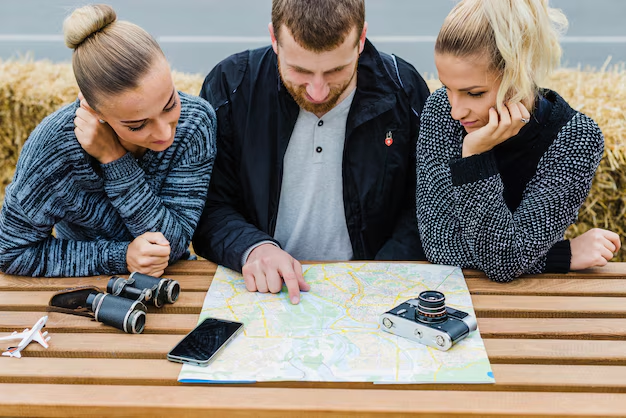Introduction
Group Travel With Friends Traveling with friends can be one of the most enriching experiences you’ll ever have. Shared adventures, inside jokes, unforgettable moments – these are the ingredients that make group trips special. Whether it’s a weekend getaway, a road trip, or an international holiday, exploring new places together deepens friendships and creates memories that last a lifetime. However, as anyone who has traveled in a group can attest, things don’t always go as planned. Conflicting preferences, communication mishaps, and differing expectations can sometimes turn the most exciting vacation into a source of stress.
So, how do you keep the fun alive and avoid the drama when traveling with a group of friends? With the right preparation, communication, and a little flexibility, you can ensure that everyone has a great time without compromising on anyone’s preferences.
In this comprehensive guide, we’ll explore how to plan and execute a group trip with friends while keeping the experience enjoyable and stress-free. From choosing the right destination to managing disagreements on the road, we’ll share tips on how to navigate the potential challenges of group travel and make the most of your time together.
Key Takeaways
- Clear Communication is the foundation of a successful group trip. Ensure everyone has a say in the planning process.
- Flexible Itinerary allows for individual exploration while keeping the group dynamic intact.
- Conflict Resolution should focus on compromise and staying calm, with a mediator if needed.
- Budgeting is crucial—agree on the financial plan early and use apps to track expenses.
- Shared Experiences strengthen bonds, so make time for group activities, but also respect personal space.
Setting Expectations: The Foundation of a Drama-Free Trip
Discuss Group Travel Goals
Before you even begin planning, it’s essential to have an open discussion about what everyone expects from the trip. Everyone in the group might have different ideas about what constitutes a perfect vacation. One friend might want to hike, another might want to relax at the beach, and yet another could be keen on sightseeing.
To prevent tension, sit down together and outline what everyone’s priorities are. Discuss:
- The trip’s focus: Do you want it to be adventure-filled, relaxing, cultural, or a combination of all?
- Budget considerations: Are you aiming for a budget-friendly trip, or is a more luxurious experience on the cards?
- Travel style: Will you be using public transport, renting a car, or flying? Are you comfortable with shared accommodations or prefer more privacy?
By having these discussions early on, you can avoid surprises later, and you’ll all be on the same page from the start.
Establish Roles and Responsibilities
For group travel to be smooth, it’s helpful if everyone takes on a specific role. This could involve:
- The Planner: Someone who organizes the itinerary, books flights, and arranges accommodations.
- The Budget Keeper: Someone responsible for tracking the expenses and ensuring the trip remains within financial limits.
- The Communicator: A person who liaises with the group, keeping everyone informed about trip details and making sure no one is left out of important decisions.
By assigning roles, you’ll ensure that the planning process runs efficiently, and everyone feels like they have a hand in the trip’s success.
Choose the Right Destination: Finding Common Ground

One of the biggest challenges in group travel is selecting a destination that everyone will enjoy. Different people have different preferences, and some might prefer warm beaches while others crave cultural immersion or adventure in the mountains. How do you find a destination that accommodates everyone’s interests?
Consider the Interests of Everyone
Start by narrowing down the options based on the interests of the group. For example:
- Beach lovers: Consider destinations like Bali, the Caribbean, or the Greek Islands.
- Nature enthusiasts: Look into national parks like Yellowstone, Banff, or Costa Rica’s rainforests.
- Urban explorers: Major cities like Tokyo, Barcelona, or New York offer both culture and fun.
It’s also worth considering if the destination offers a variety of activities, so people can split up and enjoy individual interests if needed, but still meet up for meals or at the end of the day.
Accessibility and Travel Budget
Make sure the destination is accessible for everyone, especially when considering travel costs. If someone in the group is on a tight budget, it’s crucial to ensure that the flight costs, accommodation, and local expenses fit within everyone’s financial comfort zones.
Pro Tip: Using a group travel booking service or a cost-split app can help you track costs and manage contributions from everyone fairly.
Accommodations: Keeping the Group Comfortable
Where you stay can significantly impact the success of your group trip. While it may seem convenient to rent a large Airbnb or stay in a hotel, think carefully about how you’ll balance shared and private spaces, especially when you’re in close quarters for an extended period.
Group-Friendly Accommodation
Consider renting a large house or apartment where everyone can have their own space but still gather together. Look for places that offer communal areas like a living room or a garden, as well as multiple bathrooms to ensure everyone’s comfort.
Alternatively, resorts or all-inclusive hotels with amenities like pools, spas, and organized activities can be an excellent choice for larger groups because they offer diverse options for entertainment without straining the group dynamic.
Privacy vs. Socializing
While group travel is about spending time together, it’s also important to maintain some level of privacy. Make sure that everyone has a space to retreat to if they need some alone time. This could mean splitting into smaller groups for some activities or choosing accommodations with separate rooms or suites for added privacy.
Managing Group Dynamics: Keeping the Peace

Spending a significant amount of time with a group of people, especially friends, can be challenging. It’s natural for differences to arise, whether it’s over what activity to do next or where to eat. Here’s how to manage these situations:
Plan for Downtime
In the excitement of traveling together, it’s easy to forget that everyone needs some downtime. Exhaustion and frustration can quickly build up when everyone is constantly together. Make sure to schedule free time in the itinerary where everyone can recharge.
This can be time for shopping, lounging by the pool, taking a nap, or exploring independently. Allowing for these breaks can keep everyone from getting “group fatigue.”
Flexibility and Compromise
Not every decision needs to be a group consensus. Sometimes, it’s important to give people the freedom to do their own thing. If one person wants to visit an art gallery while others prefer to hit the beach, split up for a few hours and meet up later for dinner. Being flexible with your plans reduces conflict and keeps the trip flowing smoothly.
Handling Conflict
Conflict is inevitable in group travel, especially when there are different opinions on activities or plans. If disagreements arise, try to resolve them calmly and quickly. Listen to each other’s points of view, and remember that compromise is key.
If necessary, appoint a “mediator” to step in and facilitate the conversation if a decision is taking too long.
Budgeting: Keeping Costs in Check

Money is often a source of tension in group travel. Different members of the group may have varying budgets, and it’s crucial to manage expectations early on to prevent any misunderstandings.
Set a Budget Early
Before the trip, discuss and agree on the financial expectations for the group. Agree on a rough budget for flights, accommodations, food, and activities. If someone is on a tighter budget, consider choosing less expensive destinations or activities that allow everyone to contribute according to their means.
Track Group Expenses
Use an app like Splitwise or Tricount to keep track of shared expenses during the trip. These apps allow everyone to log their individual payments and ensure that expenses are equally divided.
Making the Most of Group Activities: Fun for Everyone
When you travel in a group, it’s important to balance activities that everyone enjoys. While some group members may be more adventurous, others may prefer a more relaxed itinerary.
Group Activities and Individual Freedom
Try to create a flexible itinerary that includes both group activities and individual free time. For instance, plan a group hike in the morning but leave the afternoon open for everyone to explore as they wish. Meeting for dinner at a local restaurant allows everyone to share their day’s experiences.
Try New Things Together
One of the best parts of group travel is trying new things together. Whether it’s taking a cooking class, going ziplining, or exploring local attractions, these shared experiences strengthen your bonds and create lasting memories.
Group Activities for All Interests: Balancing Adventure and Relaxation

To accommodate different personalities and preferences, the best approach is to plan a mix of activities that span various levels of physical exertion, excitement, and relaxation. For example, some people might love a high-energy adventure, while others prefer something laid-back. Here’s how to strike that balance:
Adventure and Outdoor Activities
For the adrenaline junkies or those looking for physical challenges, plan activities like:
- Hiking: Choose a trail that’s not too difficult, but offers beautiful views or wildlife sightings. National parks and nature reserves are great for finding varied trails that cater to different fitness levels.
- Water Sports: Kayaking, paddleboarding, jet skiing, or snorkeling are fun ways to get active on the water and explore marine life.
- Ziplining or Rock Climbing: For a bit of thrill, many adventure parks and resorts offer ziplining or rock climbing activities that are beginner-friendly but still give a rush of excitement.
Cultural or Relaxing Activities
For those who prefer a slower pace or cultural enrichment, try activities like:
- Museum or Art Gallery Visits: Explore the history and art of your destination. Many museums also have interactive exhibits for younger visitors or those new to the subject.
- Cooking Classes: A fun and educational experience, learning how to cook a local dish can bring the group together while offering a chance to relax and learn something new.
- Spas or Wellness Retreats: For a more restorative experience, consider booking a group spa day or wellness retreat. Some destinations even have hot springs or natural thermal baths that are perfect for unwinding.
- Local Sightseeing: Take a leisurely stroll through a city, explore local markets, visit historic sites, or go on a food tour.
The trick is to offer a mix of activities that allow for flexibility. If someone prefers a more relaxing day while others want to do something more intense, you can plan activities with options for both types of preferences in close proximity, such as a day trip that includes both hiking and visiting a scenic town with cafes and cultural spots.
Group Dining: Sharing Meals as an Experience
One of the best ways to bond as a group is through shared meals, whether it’s at a local restaurant, picnic, or while cooking together. Food can be a central part of your trip’s experience and provides opportunities to socialize, try new things, and relax.
Group-Friendly Dining Options
- Potluck Dinners: If you’re staying in an Airbnb or house rental, cooking meals together can be a fun and budget-friendly way to bond. Everyone can contribute by preparing a dish from their home country or a local recipe they’ve learned.
- Family-Style Restaurants: These types of restaurants often offer large platters meant for sharing. It’s a good way to sample various dishes without the hassle of individual orders.
- Street Food or Market Tours: In many countries, visiting local street food vendors or markets can be a cultural activity in itself. It’s a great way to try authentic local dishes and experience the essence of the destination.
Eating and Drinking Together
Be mindful of dietary restrictions and preferences. If you have vegetarians, vegans, or people with food allergies in the group, try to choose restaurants or activities where these dietary needs are accommodated. This ensures that everyone feels included and is able to enjoy the meals.
Free Time: Personal Exploration and Recharge
While group activities are essential, so is individual downtime. Long days of sightseeing, adventure, or even socializing can lead to fatigue. Some members of your group may need alone time to recharge, and giving everyone that opportunity can make the group dynamic smoother and more enjoyable. Here’s how to integrate free time into your itinerary:
Free Time for Personal Exploration
Schedule some free afternoons or mornings for group members to explore on their own or in smaller sub-groups. This can give people the opportunity to:
- Visit their own interest points: For example, if one person wants to explore a local art gallery, while another is interested in a local historical site, everyone can do their own thing and share stories later.
- Relax: Maybe someone just wants to nap, read a book, or unwind at a café while others go on an adventure.
A bit of personal space can recharge batteries and ensure that everyone is ready to continue enjoying group activities without feeling overwhelmed or frustrated.
Split Into Smaller Groups
If your group is large, consider breaking into smaller teams for certain activities. A smaller group might be more comfortable navigating a city tour, hiking up a challenging trail, or diving into a cooking class. Smaller groups often make for a more manageable and enjoyable experience. At the end of the day, everyone can reconvene to share experiences over dinner.
Also Read : The Ultimate Guide To Family Travel: Tips For Stress-Free Vacations
Conclusion
Group travel with friends can be an incredibly rewarding experience when done right. By setting clear expectations, maintaining open communication, and being flexible, you can avoid the drama and make the most of your time together. The key is to plan ahead, respect everyone’s interests, and allow room for individuality while fostering a shared sense of adventure.
Ultimately, the goal is to make lasting memories and enjoy each other’s company in a new environment. With these strategies, you’ll be able to navigate the ups and downs of group travel and create a trip that everyone will remember fondly.
FAQs
How do I choose the right group travel destination?
Consider the interests of all group members and choose a destination that offers a mix of activities to suit everyone. Research the costs, accessibility, and safety of the location to ensure it’s suitable for all.
What should I do if there’s a disagreement during the trip?
Stay calm and try to listen to all perspectives. Encourage compromise, and if needed, appoint someone to help mediate the situation. Focus on solutions, not the problem.
How do we split costs fairly in group travel?
Use apps like Splitwise or Tricount to track expenses and ensure everyone pays their fair share. Agree on a general budget beforehand and respect everyone’s financial limits.
What if some group members want to do different activities?
Allow for some flexibility. Plan group activities but also give everyone the freedom to explore individually during free time. Meeting up for meals or in the evening helps maintain the group dynamic.
Should we rent a house or book hotel rooms?
For larger groups, renting a house or an Airbnb can offer more space and flexibility. A hotel might be better for smaller groups or if you prefer services like housekeeping and concierge assistance.
How do I manage diverse budgets in a group?
Discuss the budget upfront and plan a trip that accommodates varying financial capabilities. Opt for activities that allow for flexible pricing, and suggest budget-friendly options for meals and excursions.
How can I keep the trip stress-free?
Focus on flexibility, communication, and maintaining realistic expectations. Allow everyone to have some personal space and keep the itinerary balanced with downtime.
